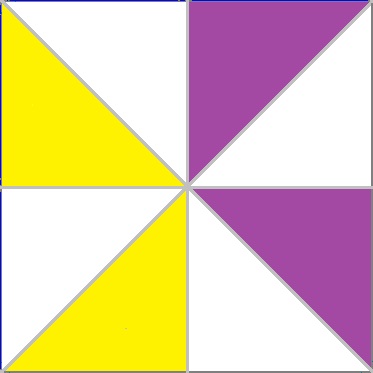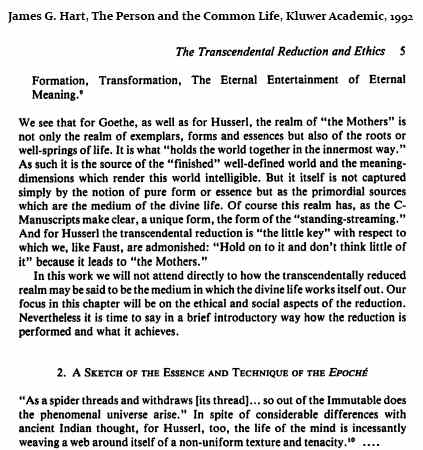
See also Trivial + Affine and Eidetic Reduction.

See also Trivial + Affine and Eidetic Reduction.
The previous Log24 post quotes Husserl on the perception
of the cube. See also Mort de Grothendieck .
The Phenomenology Part —
Art adapted from a student* artwork in a public gallery display
this month in my hometown library that I saw on March 20 —

The Multispeech Part —
From a New York Times obituary yesterday, March 22 —
https://www.nytimes.com/2024/03/22/books/lyn-hejinian-dead.html —
"With its use of ambiguous language and disjunctive sentences,
the book forsook the traditional language of autobiography,
beginning with a haunting evocation of Ms. Hejinian’s earliest memory,
her father returning from World War II:
A moment yellow, just as four years later, when my father returned
home from the war, the moment of greeting him, as he stood at
the bottom of the stairs, younger, thinner than when he had left,
was purple — though moments are no longer so colored."
I do not endorse the dead poet's philosophy, but the language is striking.
* The artist is much too young to be identified by name on the Internet,
but may (or may not) become much better known in later life.
From a New York Times obituary today . . .
"Armed with his work on the German phenomenologist Edmund Husserl,
in his late 20s and early 30s Mr. Hountondji undertook to confront head-on
'Bantu Philosophy,' a book by a Belgian missionary priest, Placide Tempels…."


"Schufreider shows that a network of linguistic relations
is set up between Gestalt, Ge-stell, and Gefüge, on the
one hand, and Streit, Riß, and Fuge, on the other . . . ."
— From p. 14 of French Interpretations of Heidegger ,
edited by David Pettigrew and François Raffoul.
State U. of New York Press, Albany, 2008. (Links added.)
One such "network of linguistic relations" might arise from
a non-mathematician's attempt to describe the diamond theorem.
(The phrase "network of linguistic relations" appears also in
Derrida's remarks on Husserl's Origin of Geometry .)
For more about "a system of slots," see interality in this journal.
The source of the above prefatory remarks by editors Pettigrew and Raffoul —
"If there is a specific network that is set up in 'The Origin of the Work of Art,'
a set of structural relations framed in linguistic terms, it is between
Gestalt, Ge-stell and Gefüge, on the one hand, and Streit, Riß and Fuge,
on the other; between (as we might try to translate it)
configuration, frame-work and structure (system), on the one hand, and
strife, split (slit) and slot, on the other. On our view, these two sets go
hand in hand; which means, to connect them to one another, we will
have to think of the configuration of the rift (Gestalt/Riß) as taking place
in a frame-work of strife (Ge-stell/Streit) that is composed through a system
of slots (Gefüge/Fuge) or structured openings."
— Quotation from page 197 of Schufreider, Gregory (2008):
"Sticking Heidegger with a Stela: Lacoue-Labarthe, art and politics."
Pp. 187-214 in David Pettigrew & François Raffoul (eds.),
French Interpretations of Heidegger: An Exceptional Reception.
State University of New York Press, 2008.
Update at 5:14 AM ET Wednesday, August 3, 2022 —

See also "six-set" in this journal.
"There is such a thing as a six-set."
— Saying adapted from a 1962 young-adult novel.
“The number one , then, has become Husserl’s touchstone
for discriminating between psychological processes and
logical laws. It is his reality detector. What is
psychological (or empirical) comes on in discrete
individual instances– ones– and you can examine their
edges. What is logical (or ideal) comes on as a
seamless oceanic unity without temporal edges….”
— Marianne Sawicki, “Edmund Husserl (1859—1938),”
Internet Encyclopedia of Philosophy
See also Roman Numeral in this journal.
The above book on Husserl was reportedly published on July 28, 2011.
See also this journal on that date.
|
"Husserl is not the greatest philosopher of all times. — Kurt Gödel as quoted by Gian-Carlo Rota Some results from a Google search — Eidetic reduction | philosophy | Britannica.com Eidetic reduction, in phenomenology, a method by which the philosopher moves from the consciousness of individual and concrete objects to the transempirical realm of pure essences and thus achieves an intuition of the eidos (Greek: “shape”) of a thing—i.e., of what it is in its invariable and essential structure, apart … Phenomenology Online » Eidetic Reduction
The eidetic reduction: eidos. Method: Bracket all incidental meaning and ask: what are some of the possible invariate aspects of this experience? The research Eidetic reduction – New World Encyclopedia Sep 19, 2017 – Eidetic reduction is a technique in Husserlian phenomenology, used to identify the essential components of the given phenomenon or experience. |
For example —
The reduction of two-colorings and four-colorings of a square or cubic
array of subsquares or subcubes to lines, sets of lines, cuts, or sets of
cuts between* the subsquares or subcubes.
See the diamond theorem and the eightfold cube.
* Cf. posts tagged Interality and Interstice.
The title refers to yesterday evening's remarks titled
"Free the Philosophical Beast" in The Stone , a NY Times weblog.
The January 2015 issue of the Notices of the American Mathematical Society
has an article by Michael J. Barany. From November 2012 remarks
by Barany :
"A highlight of the workshop was Cathryn Carson’s interpretation
of the transcendental phenomenology and historicism of Husserl,
Heidegger, Cassirer, and a few others, launched from a moving
reflection on the experience of reading Kuhn."
See Carson's paper "Science as Instrumental Reason: Heidegger, Habermas,
Heisenberg," Continental Philosophy Review (2010) 42: 483–509.
Related material: Monday's Log24 posts Rota on Husserl and Annals of Perception.
Today’s 8:01 PM post quoted Husserl on
the perception of the cube.
Another approach to perception of the cube,
from Narrative Metaphysics on St. Lucia’s Day —
 See also Symplectic Structure and Stevens’s Rock. |
From today’s 11:29 AM post —
John Burt Foster Jr. in Nabokov’s Art of Memory and
European Modernism (Princeton U. Press, 1993, p. 224) —
At the time of The Waste Land , in a comment on
Joyce’s Ulysses that influenced many later definitions
of modernism in the English-speaking world, Eliot
announced, “instead of narrative method, we may
now use the mythical method.”13
For some illuminating remarks on a mythical approach
to perception of the cube, see Gareth Knight on Schicksalstag 2012.
Part I — Unity and Multiplicity
(Continued from The Talented and Galois Cube)
Part II — "A feeling, an angel, the moon, and Italy"—
From this morning's New York Times…
"On November 12th and 13th, 2010,
a meeting of Roman Catholic bishops
convened to respond to the growing demand
for exorcism rites."
— Trailer for the film "The Rite," which opens today
Meanwhile, in this journal on November 12th and 13th, 2010… Award Show Story.
Related material — God, Time, Hopkins and a Faustian link from November 12th.
Update of 9:57 AM 1/28— The Faustian link suggests readings from
James G. Hart's The Person and the Common Life (Kluwer Academic, 1992).
See pages 1, 2, 3, 4, and 5, and note especially the spider metaphor on page 5 —


Related material suggested by last evening's NY lottery number 098—
Fear and Loathing in the Realm of the Mothers and Tarantella.
See also some notes on philosophy found yesterday afternoon.
In memory of film producer Dino De Laurentiis, who died yesterday at 91—
He is listed in Internet Movie Database under “Three Days of the Condor” as “executive producer (uncredited).”
At the end of that film, Cliff Robertson asks Robert Redford, “How do you know they’ll print it?”
One possible answer—

An interpretation for the philosophers of the Times —
See “these rich pages (586-589)” in Husserliana XV—
Zur Phänomenologie der Intersubjektivität.
Texte aus dem Nachlass. Dritter Teil: 1929-1935.
Hrsg. von Iso Kern. 1973. lxx + 742 pp.
HB. ISBN 90-247-5030-X
For related material by the author of the above phrase “these rich pages,” see “Phenomenological Time: Its Religious Significance,” by James G. Hart (pp. 17-45 in a book with the unusually ambitious title Religion and Time ).
"The present study is closely connected with a lecture* given by Prof. Ernst Cassirer at the Warburg Library whose subject was 'The Idea of the Beautiful in Plato's Dialogues'…. My investigation traces the historical destiny of the same concept…."
* See Cassirer's Eidos und Eidolon : Das Problem des Schönen und der Kunst in Platons Dialogen, in Vorträge der Bibliothek Warburg II, 1922/23 (pp. 1–27). Berlin and Leipzig, B.G. Teubner, 1924.
— Erwin Panofsky, Idea: A Concept in Art Theory, foreword to the first German edition, Hamburg, March 1924
On a figure from Plato's Meno—

The above figures illustrate Husserl's phrase "eidetic variation"—
a phrase based on Plato's use of eidos, a word
closely related to the word "idea" in Panofsky's title.
For remarks by Cassirer on the theory of groups, a part of
mathematics underlying the above diamond variations, see
his "The Concept of Group and the Theory of Perception."
Sketch of some further remarks—

The Waterfield question in the sketch above
is from his edition of Plato's Theaetetus
(Penguin Classics, 1987).
The "design theory" referred to in the sketch
is that of graphic design, which includes the design
of commercial logos. The Greek word logos
has more to do with mathematics and theology.
"If there is one thread of warning that runs
through this dialogue, from beginning to end,
it is that verbal formulations as such are
shot through with ambiguity."
— Rosemary Desjardins, The Rational Enterprise:
Logos in Plato's Theaetetus, SUNY Press, 1990
Related material—
According to the Mathematical Association of America this morning, one purpose of the upcoming June/July issue of the Notices of the American Mathematical Society is
"…to stress the inspirational role of combinatorics…."
Here is another contribution along those lines—
Eidetic Variation
from page 244 of
From Combinatorics to Philosophy: The Legacy of G.-C. Rota,
hardcover, published by Springer on August 4, 2009
(Edited by Ernesto Damiani, Ottavio D'Antona, Vincenzo Marra, and Fabrizio Palombi)
"Rota's Philosophical Insights," by Massimo Mugnai—
"… In other words, 'objectivism' is the attitude [that tries] to render a particular aspect absolute and dominant over the others; it is a kind of narrow-mindedness attempting to reduce to only one the multiple layers which constitute what we call 'reality.' According to Rota, this narrow-mindedness limits in an essential way even of [sic ] the most basic facts of our cognitive activity, as, for example, the understanding of a simple declarative sentence: 'So objectivism is the error we [make when we] persist in believing that we can understand what a declarative sentence means without a possible thematization of this declarative sentence in one of [an] endless variety of possible contexts' (Rota, 1991*, p. 155). Rota here implicitly refers to what, amongst phenomenologists is known as eidetic variation, i.e. the change of perspective, imposed by experience or performed voluntarily, from which to look at things, facts or sentences of the world. A typical example, proposed by Heidegger, in Sein und Zeit (1927) and repeated many times by Rota, is that of the hammer."
* Rota, G.-C. (1991), The End of Objectivity: The Legacy of Phenomenology. Lectures at MIT, Cambridge, MA, MIT Mathematics Department
The example of the hammer appears also on yesterday's online New York Times front page—

Related material:
From The Blackwell Dictionary of Western Philosophy—
Eidetic variation — an alternative expression for eidetic reduction
Husserl's term for an intuitive act toward an essence or universal, in contrast to an empirical intuition or perception. He also called this act an essential intuition, eidetic intuition, or eidetic variation. In Greek, eideo means “to see” and what is seen is an eidos (Platonic Form), that is, the common characteristic of a number of entities or regularities in experience. For Plato, eidos means what is seen by the eye of the soul and is identical with essence. Husserl also called this act “ideation,” for ideo is synonymous with eideo and also means “to see” in Greek. Correspondingly, idea is identical to eidos.
An example of eidos— Plato's diamond (from the Meno )—

For examples of variation of this eidos, see the diamond theorem.
See also Blockheads (8/22/08).
Related poetic remarks— The Trials of Device.
“I believe Husserl to be the greatest philosopher of all times….
Intellectual honesty is the striking quality of Husserl’s writings. He wrote what he honestly believed to be true, neither more nor less. However, honesty is not clarity; as a matter of fact, honesty and clarity are at opposite ends. Husserl proudly refused to stoop to the demands of showmanship that are indispensable in effective communication.”

Related material:
The Diamond Theorem
In Memory of
Edmund Husserl
— Stanford Encyclopedia of Philosophy
“Beauty is the proper conformity
of the parts to one another
and to the whole.”
— Classic definition quoted
by Werner Heisenberg
(Log24, May 18-20, 2005)
“It seems, as one becomes older,
That the past has another pattern,
and ceases to be a mere sequence….”
— T. S. Eliot, Four Quartets
See also Time Fold
and Theme and Variations.
Semantic Transparency
"… semantic transparency … would allow disparate systems to share some understanding of the actual concepts that are represented…"
— IBM Developer Works on October 7, 2003
"There is no neutral ground
that can serve as
a means of translating between
specialized (lower) ontologies."
There is, however,
"the field of reason"–
the 3×3 grid:
From a Log24 entry of January 7, 2007:
"One of the primary critiques of modernism that Learning from Las Vegas was engaged in, as Frederic [sic] Jameson clearly noted, was the dialectic between inside and outside and the assumption that the outside expressed the interior. Let's call this the modernist drive for 'expressive transparency.'"
— Aron Vinegar of Ohio State U., "Skepticism and the Ordinary: From Burnt Norton to Las Vegas"
From this week's New Yorker (issue dated Jan. 22, 2007)–
"A Life," by Zbigniew Herbert
(translated from the Polish by Alissa Vales):
I was a quiet boy a little sleepy and–amazingly–
unlike my peers–who were fond of adventures–
I didn't expect much–didn't look out the window
At school more diligent than able–docile stable
For the rest of the poem, click here.
From the Wikipedia article on Zbigniew Herbert:
"In modern poetry, Herbert advocated semantic transparence. In a talk given at a conference organized by the journal Odra he said: 'So not having pretensions to infallibility, but stating only my predilections, I would like to say that in contemporary poetry the poems that appeal to me the most are those in which I discern something I would call a quality of semantic transparency (a term borrowed from Husserl's logic). This semantic transparency is the characteristic of a sign consisting in this: that during the time when the sign is used, attention is directed towards the object denoted, and the sign itself does not hold the attention. The word is a window onto reality.'"
(Wikipedia cites as the source–
Herbert's talk at the meeting "Poet in face of the present day," organized by the "Odra" journal. Print version: Preface to: Zbigniew Herbert "Poezje," Panstwowy Instytut Wydawniczy, Warszawa 1998, ISBN 83-06-02667-5.)
Fom Nabokov's Transparent Things (pdf):
"Its ultimate vision was the incandescence of a book or a box grown completely transparent and hollow. This is, I believe, it: not the crude anguish of physical death but the incomparable pangs of the mysterious mental maneuver needed to pass from one state of being to another. Easy, you know, does it, son."
Related material:

Powered by WordPress